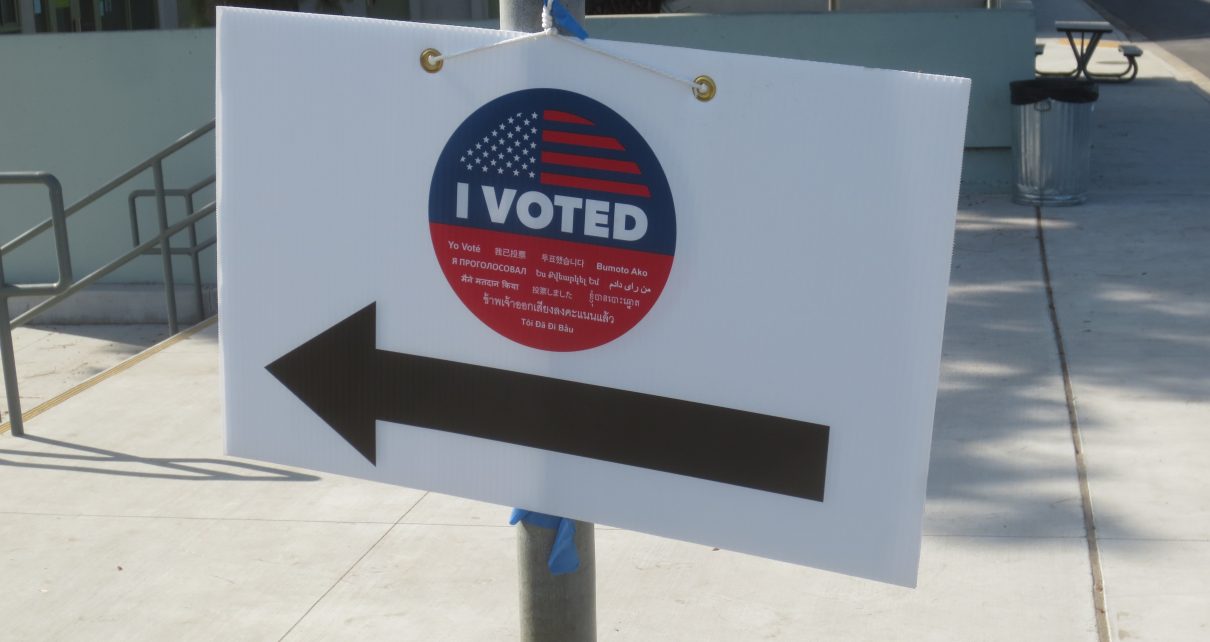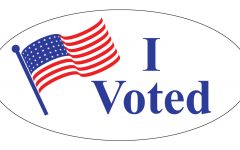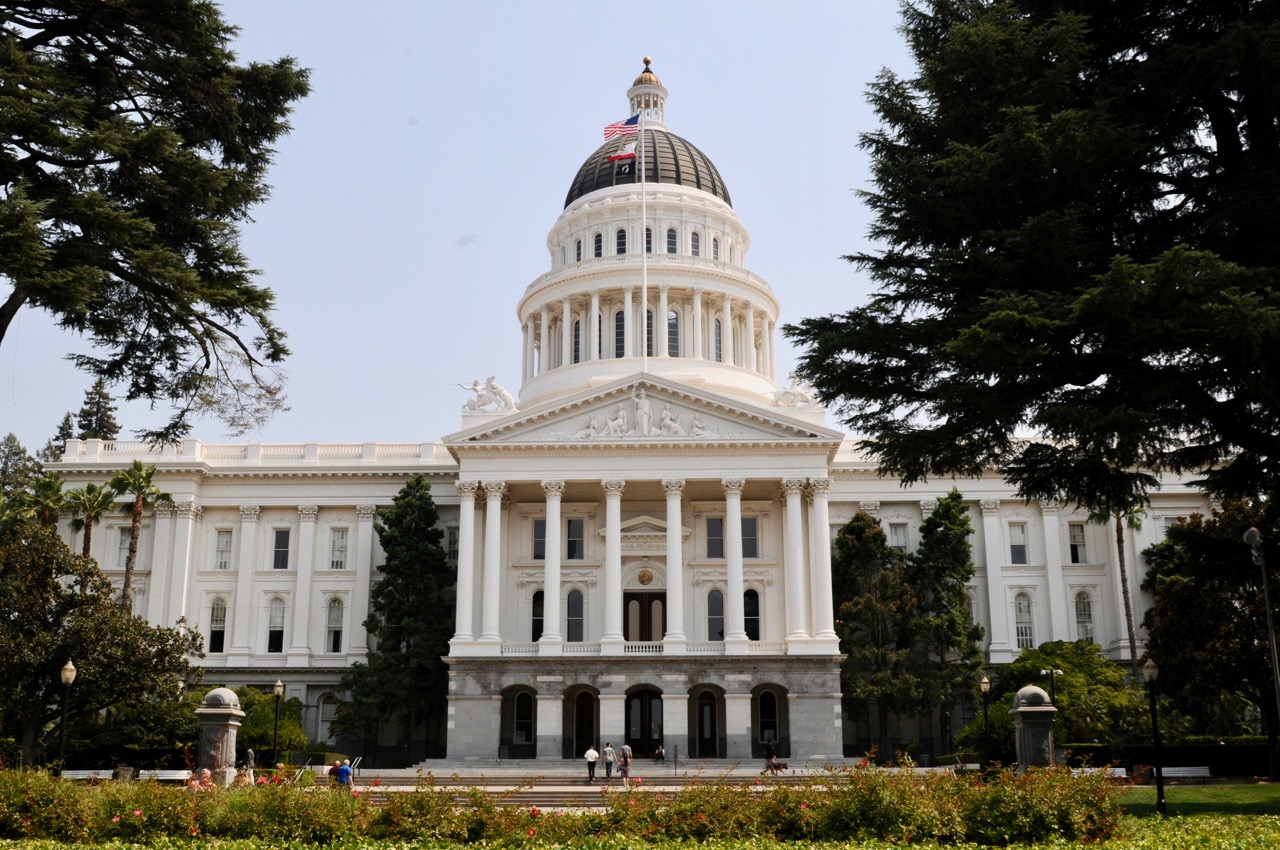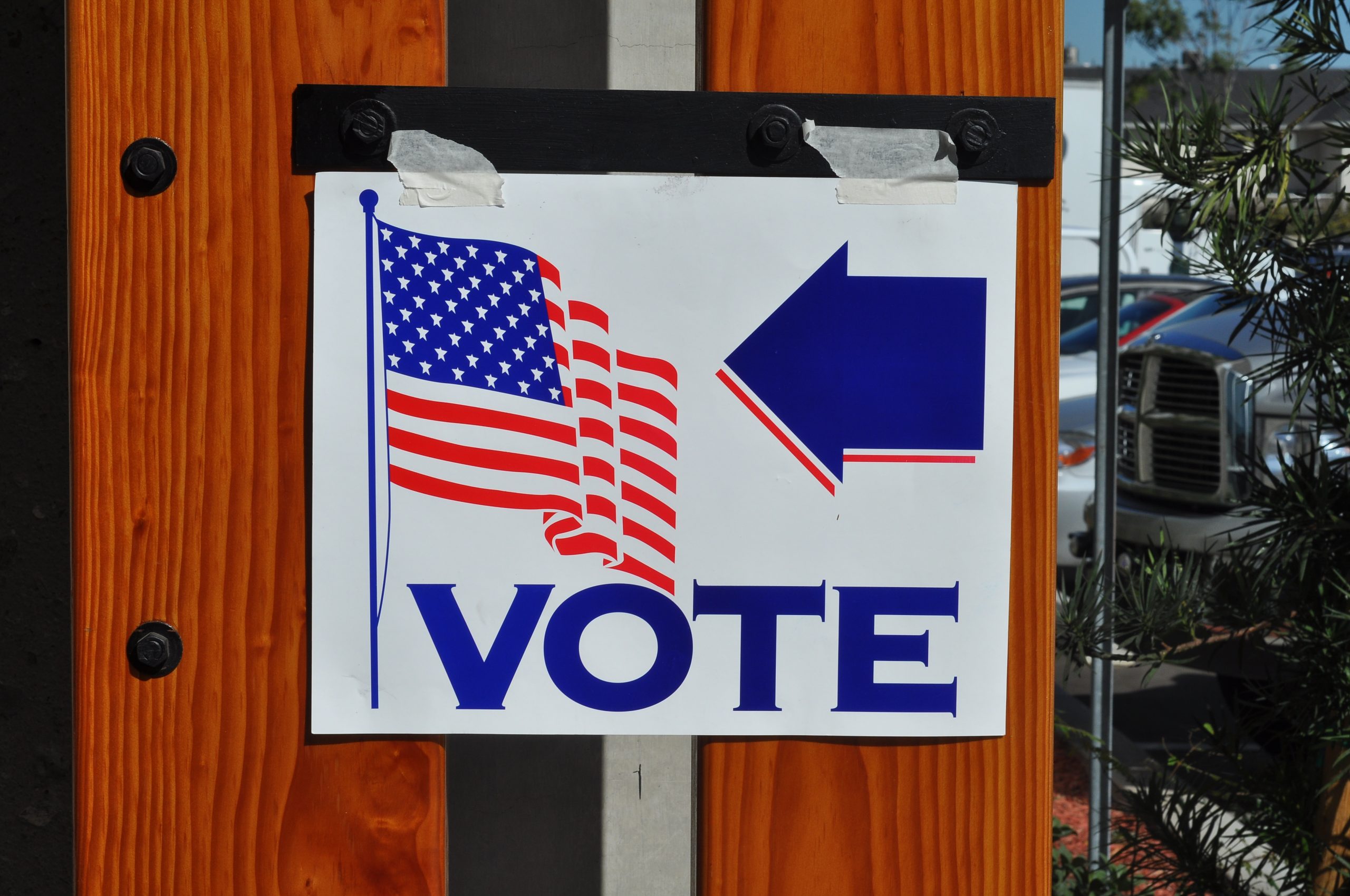
Voting sign in Pasadena, CA November 3, 2020 (Photo: Evan Symon for the California Globe)
Low Voter Turnout Across California Reported on Primary Day
‘No one seems to care that the balance of the state is in their hands’
By Evan Symon, June 7, 2022 3:37 pm
Voter turnout for the 2022 California primaries remained low Tuesday with many polling places and buildings with vote drop-offs reporting fewer people coming in than previous elections.
Earlier this week, consulting firms projected that California was likely going to see less than 30% turnout from voters largely due to a lack of exciting races in most places, disappointment from the results and actions from several previous elections, high voter apathy, along with other reasons. While the amount of ballots in on Monday was reported to only be 15%, the amount barely ticked up on Tuesday with the consulting firm Political Data Intelligence (PDI) announced mid-Tuesday that it only moved up to 16%.
While low numbers of people coming in have been universal, some areas are seeing higher numbers than other places. In San Francisco, the recall election of DA Chesa Boudin has brought out many voters either in support of Boudin’s policies or those dead-set against them.
“Over half the people who voted here or dropped off a ballot so far mentioned the race unprompted,” said John, a poll worker in San Francisco, to the Globe. “That’s the election everyone knows about. Pelosi and Newsom, and everyone, they’re an afterthought for most people it seems. A few going into the booths are also only coming out seconds later. It’s obvious they are only voting on the Boudin recall. It’s been like that all day.”
In the North County area above the Bay Area and Sacramento, it was even quieter for the first half of Tuesday.
“Due to the population differences, there’s not as many polling places up here, or vote drop off spots as you would see in LA or San Diego,” explained another election volunteer who wished to remain anonymous. “But even with fewer options, we’ve still just seen a trickle. There’s some local stuff and Congressman and Assemblyman up, as well as Governor, but it’s not like the Newsom recall last year where we had parking problems for the first election here since the Obama-McCain one. There’s no real motivation.”
Low voter turnout
Down South in Los Angeles, a high-profile election, the Mayoral Primary, is also boosting voter figures, but not as much as previously thought.
“I’ve been a volunteer at these places for years,” explained Deborah, a Los Angeles polling center worker, to the Globe on Tuesday. “Even for a primary, we have seen fewer people than normal, and I’m taking into account all those people that vote early or by-mail. Usually we see a large number of people come in just before closing because of them being at work or forgetting until the last minute, but based on the handful of people that came in today so far, I seriously doubt we’ll see lines like we’ve seen in the past. And if the Mayoral election has more people coming than what it would have, it’s really disappointing. I mean, a new mayor may be chosen today if Bass or Caruso get above 50% of the vote from a pool of voters in LA that is, I don’t know, 25%? 30%? That’s not good.”
Next door in Pasadena, with local spots such as City Council positions up for grabs, turnout is also low, with many voters seemingly unconcerned with many of the elections.
“You wouldn’t believe how many people here said they had all the candidates stop by their door during the last several months and them not wanting to have any of them in,” explained Gerald Damons, a supporter for a local candidate campaigning outside a polling center in Pasadena, to the Globe on Tuesday. “I feel sorry for exit pollers because it is obvious that not everyone is voting down the ballot. Many voters actually said to me that they stopped after seeing so many races without someone running against them. It was good to see a lot of young people excited about voting for the first time, because it gives you hope for the future, but even then many were coming in only knowing about a few of the races.”
Finally one polling center worker from Fresno simply gave this as a response: “No one seems to care that the balance of the state is in their hands.”
While the number of voters will likely climb throughout Tuesday, as of Tuesday afternoon, the projection of total turnout being under 30% seems more and more realistic.
- Bill to Require Law Enforcement Disclosure if AI Was Used To Help Write Reports - August 7, 2025
- Gov. Newsom Files FOIA Request To ‘Expose True Cost’ Of L.A. Federal Troop Deployment for Anti-ICE Riots - August 6, 2025
- California Redistricting: How Newsom’s Plan Will Demolish Hard Fought GOP Gains - August 6, 2025





What on earth is wrong with Californians?
Nothing. Democrats rule CA with an iron fist. Most voters know this will never change.
I am not buying it. There is something rotten in Denmark. Me thinks more hijinks are in play from the Secretary of State’s office. This person is not to be trusted: https://www.sos.ca.gov/administration/about
The have sequestered the entire ballot scanning system into one central location for each voting region away from the public. There is no one publicly auditing or verifying these votes. Expect those in power to cheat per usual.
I concur… the change in voting procedures is DEEPLY troubling… Ventura County USED to run the Scan-tron ballot through the machine RIGHT IN FRONT OF YOU, and you could see that it had incremented on the ballot counter (whether it was counted is another discussion for another time)…
Now we have loosey-goosey, mail-in ballots, and even if we take the ballot to our “voting center” instead of our precinct, all we do is drop the envelope in the ballot and Lord only knows where it goes or what happens to it after that…
This is all Democrat “trust us” bovine excrement – supposedly the “Ballotrax” system works but as of almost 6PM today, my ballot has STILL not been processed apparently, and going to the SOS website says that the vote will not be finalized until MID-JULY???
What the ????
How much shenanigans can go on for that length of time???
This state is DOOMED with these wide-open “elections” that have Dominion at their core, with all of these weaknesses that were documented by a testing firm, and signed off by Padilla before he skated off to take Kackling Kamala’s Senate seat…
https://votingsystems.cdn.sos.ca.gov/vendors/dominion/dvs510staff-report.pdf
(Focus on the exceptions that are explained away repeatedly between pages 20-29 or so….)
BIG Red FLAG : “During the Requirements examination and the Open Ended Vulnerability Testing
(OEVT) portion of the testing, issues were noted related to audit logging, passwords,
anti-virus, and installation aspects of the voting system. It should be noted that these
issues do not directly affect the overall function of the voting system and could
potentially be alleviated with manual processes and procedures. In many cases the
issues discovered were not in relation to public facing voting system components and
required elevated systems permissions for access or manipulation.
It should be noted that proper secure utilization of the voting system solution is reliant
upon properly trained personnel, as well as following all processes and procedures set
forth to ensure properly configured and secured equipment for use in a live election
environment.”
Red flag # 2 ( pg 23) : “The findings can be mitigated by rigorous manual adherence to industry best practices of password/passcodes.”
Red flag # 3 (pg 24) : “Review of the requirement 7.4.2, showed that on the EMS Server, the AVAST
Antivirus (AV) File Shield (the real time AV monitor) was only able to detect and
clean one of the four European Institute for Computer Antivirus Research (EICAR)
files which potentially leaves the system open to zipped and double zipped viruses
as well as infection strings in plain text.
The ICX system is an android tablet device and contains no form of AV protection.
The ICE and ICP2 systems are proprietary systems that utilize firmware and
compact flash cards to run, load, and store election-based software. These
systems contain no operating system and no AV protection.
Testing demonstrated that the requirement was partially covered. The findings can be
mitigated by rigorous adherence to physical security processes and procedures, which
would preclude the introduction of any malicious applications. ”
Red flag #4 (pg. 25) : “SLI (testing firm) believes it would be possible to inject more lethal payloads into the installers given the opportunity. This would require an insider with unhindered access to the
system to edit the source code.”
Red flag #5 (pg. 26) : “It was determined that the Dell managed switch was not sufficiently hardened
during the engagement, this included an unencrypted telnet server with default
username and password combinations. The findings can be mitigated by rigorous
adherence to manufacturer specifications of hardening the switch, including encryption
and use of non-default username/password combinations.”
Red flag #6 (pg. 27) : ” The managed switch was scanned with Nessus and determined to have 12
medium vulnerabilities, and four low vulnerabilities. The switch is isolated from public
networks, and access control policies limit who has access to the physical device. This
can be mitigated by rigorous adherence to manufacturer specifications of hardening of
the switch, including encryption and use of up to date security certificates.
Testing demonstrated that the requirement was partially covered. The findings can be
mitigated by rigorous adherence to manufacturer specifications of hardening of the
switch, including encryption and use of up to date security certificates. ”
Red flag #7 (pg. 28) – “General Notes
It was noted during the installs that the EMS server utilizes DHCP for workstation
address assignment, and as such this system would be susceptible to a DHCP
starvation attack whereby a malicious device sends requests to the server and leases
all the addresses available, or just provides bogus addresses to clients. The attacker
would require physical access to the system, and would plug in a small box, or a small
COTS router into the RTR network in order to supply bad addresses. This is mitigated
by procedural controls and access controls to the physical network.
The ICX ballot marking device uses an encrypted QR code, but includes human
readable results on the ballot. This QR code is encrypted, and cannot be read by any
other machine except a Dominion device. This requires that the voter trust the machines
in order to verify that the human readable results on the ballot are correct. This is
mitigated by procedural controls and review by the voter prior to printing the ballot.
The ICE machine includes a design characteristic that merits some attention. Any
machine that includes ballot marking and deposit into the ballot box in the same paper
path, is not software independent, and could be compromised in a way that is
undetectable with a manual tally or risk limiting audit. The ballot-marking printer is in the
same paper path as the mechanism to deposit marked ballots into an attached ballot
box. This opens up a security vulnerability: the voting machine can mark the paper
ballot (to add votes or spoil already-cast votes) after the last time the voter sees the
paper, and then deposit that marked ballot into the ballot box without the possibility of
detection. Vote-stealing software could easily be constructed that looks for undervotes
on the ballot, and marks those unvoted spaces for the candidate of the hacker’s choice.
This is very straightforward to do on optical-scan bubble ballots (as on the Dominion
ICE) where undervotes are indicated by no mark at all. The autocast configuration
setting that allows the voter to indicate, “don’t eject the ballot for my review, just print it
and cast it without me looking at it.” If fraudulent software were installed, it could change
all the votes of any voter who selected this option, because the voting machine software
would know in advance of printing that the voter had waived the opportunity to inspect
the printed ballot. This would be mitigated by using the ICE for accessible sessions
only. Additionally, the ICE should include procedural controls whereby a technician
completes the L&A procedures prior to an election, and then a second technician goes
through the validation procedure to validate the firmware and software on the ICE, and
then applies the seals to the machine. Any ICE that is presented at a polling place with
broken seals should be replaced.”
Red flag #8 (pg. 29 ) : “During the ICX source code vulnerability review, one potential vulnerability was
discovered and the level of access required to take advantage of this potential
vulnerability would be open to a variety of actors including a voter, a poll worker, an
election official insider, and a vendor insider. This potential vulnerability has a more
widespread potential. Polling place procedural controls are one method of mitigating this
issue, with poll workers actively verifying that the USB ports are covered and the covers
sealed to prevent access.”
Has the pg 25 observation been implemented where the “central processing” system has been rigged so that every “Republican” vote is recorded as .75 of a vote and every “Democrat” vote is recorded as 1.25 of a vote???
Can anyone answer this with confidence???
This one is SO important that it needs to be called out :
“Vote-stealing software could easily be constructed that looks for undervotes
on the ballot, and marks those unvoted spaces for the candidate of the hacker’s choice.
This is very straightforward to do on optical-scan bubble ballots (as on the Dominion
ICE) where undervotes are indicated by no mark at all. The autocast configuration
setting that allows the voter to indicate, “don’t eject the ballot for my review, just print it
and cast it without me looking at it.” If fraudulent software were installed, it could change
all the votes of any voter who selected this option, because the voting machine software
would know in advance of printing that the voter had waived the opportunity to inspect
the printed ballot. This would be mitigated by using the ICE for accessible sessions
only.”
Good news
Californians don’t trust the system. Mail in voting under dick tator Newsoms emergency declaration is the problem and unconstitutional The high turnout at recall time was to get him out not in support of this @$$hole. So it’s evident people have lost faith in there vote counting.
The best kept secret is how many ballots sent to “last known address” were returned. How many were left for ballot harvesters, how many were sold to ballot harvesters by the mail carrier, and how many were returned by the mail carrier.
When you get a report from CISA that the Voting machines are compromised and yet California keeps on using them, why should I vote? We have to get rid of the machines and go to paper ballots and hand counts to have a free and fair election.
Please see my earlier comment for an explanation of why James’ comment is a valid one…